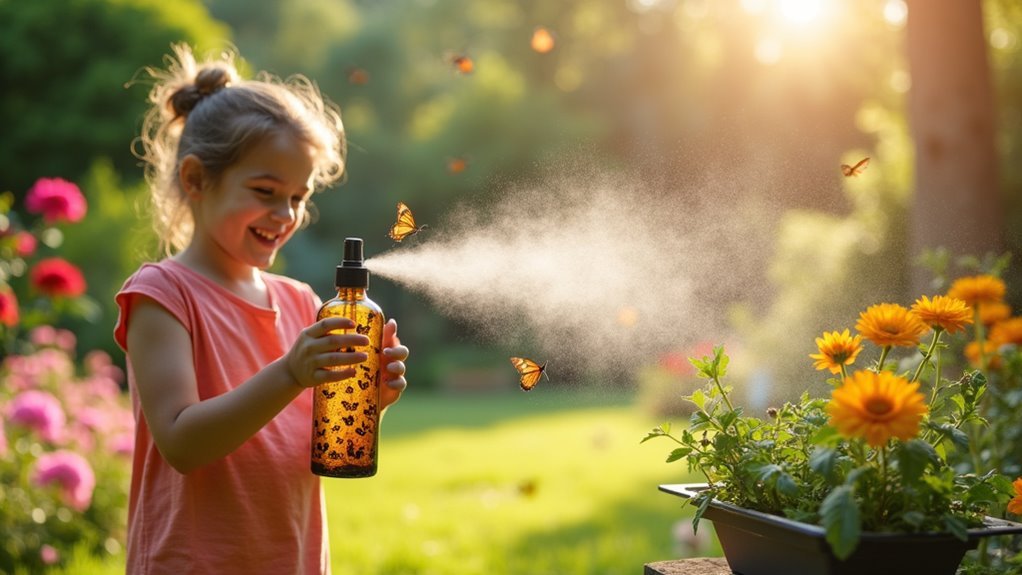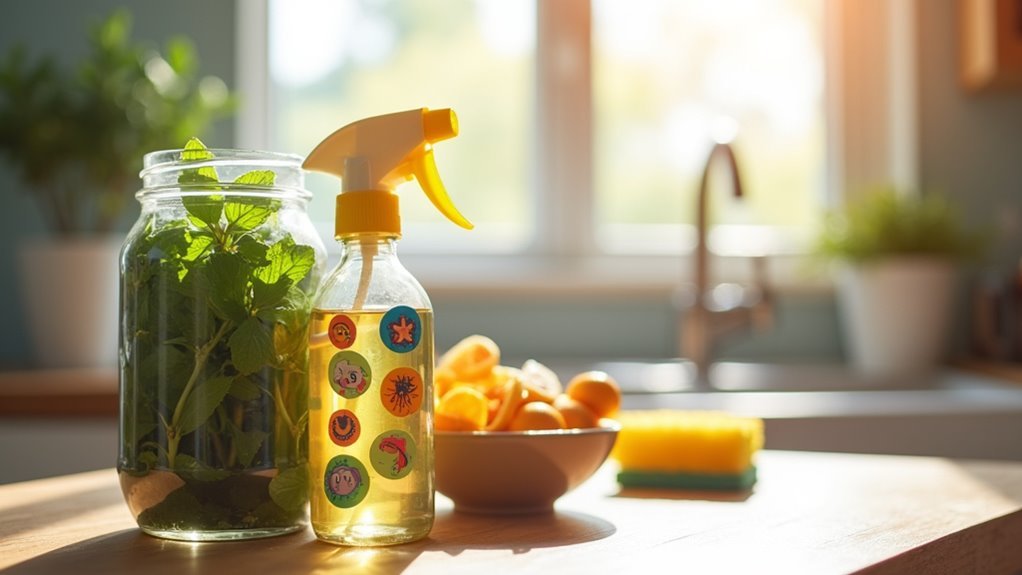You can protect your children from bugs using natural alternatives that are safer than harsh chemical repellents. Create essential oil sprays with lavender, tea tree, or peppermint mixed with water, and strategically place kid-safe plants like marigolds and citronella around play areas. Use fans to create airflow barriers, eliminate standing water sources indoors, and try dryer sheets in pockets for portable protection. These gentle methods keep insects away while ensuring your family’s safety and well-being outdoors.
Essential Oil Bug Sprays Safe for Children

Since traditional bug sprays often contain harsh chemicals that concern parents, essential oil alternatives offer a gentler approach to protecting children from insect bites.
Essential oil bug sprays made with lavender, tea tree, and peppermint oils effectively repel insects without exposing children to harsh chemicals.
Essential oils like lavender, tea tree, and peppermint create effective bug sprays that protect children naturally without harmful chemical exposure.
You can create your own spray by mixing 30 drops of essential oil with water in a spray bottle. Citronella works well against mosquitoes but use it moderately to prevent skin irritation.
Always perform a patch test on a small skin area before full application to check for allergic reactions.
These natural sprays provide pleasant scents while keeping bugs at bay, making outdoor activities more enjoyable and safer for your children.
Strategic Placement of Kid-Safe Plants
Beyond creating homemade sprays, you can establish a natural defense system by strategically placing bug-repelling plants throughout your outdoor spaces. These kid-safe plants offer dual benefits: they’re non-toxic to children while effectively deterring insects from areas where your family spends time.
Focus placement near entry points like doors and windows, plus around outdoor play areas where kids are most active. Native varieties require less maintenance, making them practical choices for busy families.
| Plant Type | Effective Against | Best Placement |
|---|---|---|
| Citronella/Lemongrass | Mosquitoes | Near seating areas |
| Chrysanthemums | Ants, beetles, ticks | Garden borders |
| Lavender/Marigolds | General insects | Doorways, windows |
This landscaping approach creates colorful, aromatic spaces that naturally protect children while enhancing your home’s outdoor appeal.
Using Fans to Create Bug-Free Indoor Zones

Circulation holds the key to creating effective indoor bug barriers without chemicals or complex equipment. Fans create airflow that disrupts mosquitoes and flying insects, making it nearly impossible for them to navigate and land in your home.
Here’s how to keep bugs away using strategic fan placement:
- Position oscillating fans near doorways and windows to create air barriers that insects won’t cross.
- Install ceiling fans in main living areas to maintain constant air circulation throughout rooms.
- Place portable fans in corners where bugs typically gather or enter.
- Use larger outdoor fans on patios to extend bug-free zones to deck and gathering spaces.
You’ll notice immediate results as the continuous airflow makes your indoor environment uncomfortable for flying pests while keeping your family cool and comfortable.
Dryer Sheets as Natural Pest Deterrents
You’ll find that dryer sheets work as natural pest deterrents because they contain linalool and beta-citronellol, compounds that effectively repel mosquitoes and other flying insects by masking scents that attract bugs.
You can safely apply this method by tucking sheets into your child’s pockets, pinning them to clothing, or placing them in nearby areas where kids play outdoors.
This non-toxic approach offers a simple way to reduce bug encounters without exposing children to harsh chemical repellents.
How Dryer Sheets Work
While most people associate dryer sheets with fresh laundry, these household staples pack a surprising punch against pesky insects.
You’ll find that dryer sheets work through multiple mechanisms to keep bugs at bay:
- Chemical compounds – Linalool and beta-citronellol naturally repel mosquitoes and flies
- Scent masking – The fragrance covers human odors that typically attract insects
- Portable protection – You can easily carry them in pockets or pin to clothing
- Proven effectiveness – Studies show significant decreases in bug encounters
When you use dryer sheets outdoors, you’re creating an invisible barrier that insects prefer to avoid.
Though they’re not replacements for EPA-approved repellents, dryer sheets offer a chemical-free alternative that’s generally safe around children during camping trips, picnics, or backyard activities.
Safe Application Methods
When applying dryer sheets for bug protection around children, proper placement guarantees maximum effectiveness while maintaining safety. You can easily pin these kid-friendly sheets to clothing or tuck them into pockets for portable protection. The linalool and beta-citronellol compounds work continuously without exposing children to harsh chemicals.
| Location | Method | Duration |
|---|---|---|
| Clothing | Pin to shirt/pants | 4-6 hours |
| Play areas | Scatter around perimeter | All day |
| Outdoor gear | Attach to backpacks/chairs | 6-8 hours |
| Picnic spots | Place under tablecloths | 4-5 hours |
Strategic placement creates bug-free zones where children can play comfortably. Replace sheets when their scent fades, typically after several hours outdoors. This non-toxic approach keeps insects away while ensuring your family’s safety during outdoor activities.
Eliminating Indoor Water Sources

You’ll want to scout out those sneaky water spots that bugs love – think under sinks, behind appliances, and around window sills where condensation builds up.
Don’t forget to peek into closets and storage areas where leaky pipes might be creating hidden puddles.
Keep your drains flowing smoothly by cleaning them regularly, since clogged drains create perfect breeding grounds for various insects.
Check Hidden Water Spots
Hidden water sources throughout your home create perfect breeding grounds for mosquitoes, gnats, and other unwanted insects.
You’ll need to check hidden water spots regularly to prevent these pests from taking over. Standing water in unexpected places provides ideal conditions for bug reproduction, making your home less comfortable for your family.
Focus your attention on these key areas:
- Under sinks and appliances – Inspect refrigerator drip trays and plumbing connections for leaks.
- Bathroom accessories – Dry shower curtains and bath mats thoroughly after each use.
- Pet areas – Empty and refill water bowls daily, especially during warm weather.
- Humidifiers and air conditioning units – Clean and dry these devices when not actively running.
Regular maintenance prevents infestations before they start.
Regular Drain Maintenance
Beyond these obvious water collection points, your home’s drain system presents another major opportunity for bug control. You’ll want to regularly check and clean drains to prevent stagnant water buildup that attracts mosquitoes and other insects.
| Location | Action | Frequency |
|---|---|---|
| Kitchen/bathroom sinks | Clear debris and standing water | Weekly |
| Shower drains | Remove hair and soap buildup | Bi-weekly |
| All drains | Flush with hot water/vinegar | Monthly |
Install drain covers or screens to block leaves and materials that create clogs. Don’t forget areas around indoor plants—overwatering creates excess water in pots, contributing to standing water issues. Schedule periodic maintenance to eliminate blockages and reduce odors that attract pests to your home.
Child-Safe Citronella Applications
When mosquitoes threaten your family’s outdoor fun, citronella offers a gentle yet effective solution that’s safe for children. This non-toxic natural repellent provides reliable protection without harsh chemicals.
Here are four effective ways to use citronella around kids:
- Place citronella candles on outdoor tables to reduce mosquito landings by 42%, keeping them safely out of children’s reach.
- Use citronella wristbands for convenient, continuous protection without direct skin application.
- Apply citronella oil sparingly in play areas to create protective barriers while avoiding skin irritation.
- Choose child-safe labeled products and follow manufacturer instructions for proper application.
Always verify products are specifically labeled as child-safe before use.
Citronella-infused sprays work effectively in outdoor spaces where children play, providing peace of mind for parents.
Baby Powder for Flying Insect Control
You’ll find that baby powder’s talc content naturally repels flying insects like wasps and bees when sprinkled around outdoor areas.
The powder works by creating a scent barrier that insects avoid, while the fine particles disperse easily in the wind to cover larger spaces.
This method’s completely non-toxic, making it perfect for families who need effective bug control without exposing children to harsh chemicals.
How Baby Powder Works
Baby powder’s effectiveness against flying insects stems from its talc-based composition, which disrupts these pests’ ability to navigate and fly properly.
When you sprinkle this household staple around entry points, you’re creating an invisible defense system that keeps wasps and other flying bugs at bay.
Here’s how baby powder works as your insect deterrent:
- Physical interference – Fine talc particles cling to insects’ wings, making flight difficult
- Scent barrier – The powder’s aroma confuses insects’ navigation systems
- Wind dispersal – Air currents carry the particles and scent further from application points
- Enhanced potency – Mixing cinnamon with baby powder amplifies the deterrent effect
You’ll appreciate that this non-toxic approach keeps your family safe while effectively preventing insect invasions through windowsills and doorways.
Safe Application Methods
While baby powder offers excellent protection against flying insects, proper application guarantees maximum effectiveness without creating unnecessary mess or waste.
Start by sprinkling a thin, even layer around windowsills and doorframes where wasps typically enter. You’ll want to focus on garden areas near flowers where these insects gather most frequently.
For enhanced results, mix baby powder with cinnamon before applying – this combination creates a stronger deterrent scent.
Don’t oversaturate areas; a light dusting works best and won’t create cleanup issues for kids playing nearby.
Wind naturally helps disperse the powder’s scent, extending its protective range.
Reapply after heavy rain or strong winds to keep insects away effectively. This gentle method maintains protection without exposing children to harsh chemical repellents.
LED Light Switches to Reduce Bug Attraction
Since traditional incandescent and fluorescent bulbs generate significant heat and emit short wavelengths that attract insects, switching to LED lighting offers a simple yet effective way to reduce bug problems around your home.
LED light bulbs emit longer wavelengths that many insects avoid, creating a less inviting environment for flying pests. The reduced heat production also makes your outdoor areas less attractive to bugs seeking warm light sources.
LED bulbs produce longer wavelengths and less heat, making outdoor spaces naturally less attractive to insects and flying pests.
Here’s how to maximize bug reduction with LED lighting:
- Choose warm-colored LED bulbs that emit the longest wavelengths insects find least appealing.
- Replace all outdoor porch and patio lighting with energy-efficient LED options.
- Install LED lights in areas where your family spends evening time outdoors.
- Take advantage of LED longevity to maintain consistent bug-repelling benefits without frequent replacements.
Your family can enjoy outdoor spaces more comfortably during peak bug activity times.
Homemade Vinegar-Based Repellent Solutions
When you want to create a safe, chemical-free barrier against bugs, homemade vinegar-based repellent solutions offer an effective and budget-friendly alternative that won’t harm your children or pets.
You’ll need one pint of distilled white vinegar and one pint of water in a spray bottle. For enhanced effectiveness, add 25 drops each of tea tree oil and lavender essential oil to boost the insect-repelling properties.
These homemade vinegar-based repellent solutions work by masking attractive scents that lure insects to your outdoor areas. Simply spray the mixture around targeted spaces for immediate protection.
You can also use a diffuser stick to disperse the solution continuously, creating a pleasant aroma while maintaining effective bug deterrence throughout your yard.
Safe Application of Natural Repellents on Kids
Although natural repellents offer safer alternatives to chemical-based products, you’ll need to follow specific guidelines when applying them to your children’s skin.
Natural repellents containing citronella or essential oils require careful handling to guarantee your child’s safety and comfort.
Follow these essential application steps:
- Choose age-appropriate products – Select natural repellents specifically labeled safe for children, avoiding products with harsh essential oil concentrations.
- Apply to exposed skin only – Keep the repellent outside of clothing to minimize irritation and guarantee proper coverage of vulnerable areas.
- Supervise application carefully – Use adequate coverage without over-applying, which can cause skin reactions or discomfort.
- Wash off after use – Remove natural repellents when returning indoors, especially before meals or bedtime, and store products safely away from children’s reach.
Creating Smoke Barriers Safely Around Children
Beyond topical applications, you can create effective smoke barriers that naturally repel insects while keeping your children safe.
Use a fireproof container to burn cattails or rotten wood, positioning the smoke upwind from where kids are playing. Always supervise children during this process, maintaining a safe distance to prevent smoke inhalation.
Only implement these barriers during outdoor activities with guaranteed adult supervision in well-ventilated areas. Before starting, check local regulations for burn bans or fire restrictions to guarantee compliance.
Choose natural materials like dried leaves or herbs for smoke generation—they’ll provide pleasant aromas while keeping bugs away. This method creates an effective perimeter that protects children from bothersome insects naturally.
Physical Barriers and Mesh Protection
While smoke barriers offer one effective solution, physical barriers provide the most reliable protection against insects without any safety concerns about fire or inhalation.
You’ll find mesh protection creates safe zones where your children can play comfortably outdoors.
Here are four essential physical barriers to implement:
- Install mosquito nets around outdoor play areas and patios to create effective insect-free zones.
- Add mesh screens to windows and doors for indoor protection while maintaining fresh air circulation.
- Cover food and dining areas with mesh during outdoor meals to prevent bites and irritations.
- Use portable screen tents for bug-free play zones during family outings and picnics.
Remember to secure all barriers properly and check for tears regularly to maximize their effectiveness in protecting your children’s health.
Teaching Kids About Bug Prevention Safety
Physical barriers work best when your children understand how to protect themselves independently. Teaching kids about bug prevention safety empowers them to make smart decisions outdoors. Start by explaining how standing water breeds mosquitoes, encouraging them to empty containers after rain. Show them protective clothing benefits – long sleeves and pants create barriers against bites.
Help children recognize bug-attractive areas like tall grass and flowered gardens where insects gather. Involve them in planting natural deterrents like marigolds or lemongrass to demonstrate eco-friendly pest control.
Most importantly, teach safe bug repellant application. Kids must understand to apply it only on exposed skin and wash it off when returning indoors.
| Safety Topic | Child’s Action | Parent’s Role |
|---|---|---|
| Standing Water | Empty containers | Supervise checking |
| Protective Clothing | Choose long sleeves | Provide options |
| High-Risk Areas | Avoid tall grass | Identify locations |
| Natural Plants | Help garden | Guide planting |
| Bug Repellant | Apply safely | Demonstrate use |
Frequently Asked Questions
What Is the Best Bug Repellent for Children?
You’ll want EPA-registered repellents containing DEET, picaridin, or oil of lemon eucalyptus for your children. These proven ingredients are safe and effective when you apply them properly on exposed skin areas.
How Do You Make Natural Bug Repellent for Kids?
You’ll mix 1 pint distilled white vinegar with 1 pint water in a spray bottle, then add 25 drops each of tea tree and lavender essential oils for effective protection.
What Scent Will Keep Bugs Away?
You’ll find citronella effectively repels mosquitoes, reducing landings by 42%. Essential oils like peppermint and rosemary deter flies and ticks. Dryer sheets containing linalool also work, while lemongrass and marigolds provide natural protection.
What Can I Put on My Child to Prevent Bug Bites?
You can apply EPA-approved insect repellents containing DEET or picaridin to your child’s exposed skin. Use stick, lotion, or spray forms, avoiding hands and face. Supervise application and wash off when indoors.
In Summary
You’ve got plenty of kid-friendly options to keep bugs at bay without harsh chemicals. From essential oil sprays to strategic plant placement, you’re creating a safer environment for your family. Remember to combine multiple methods like fans, physical barriers, and eliminating water sources for the best results. Most importantly, you’re teaching your children valuable prevention habits that’ll serve them throughout their lives while keeping everyone comfortable and bite-free.





Leave a Reply